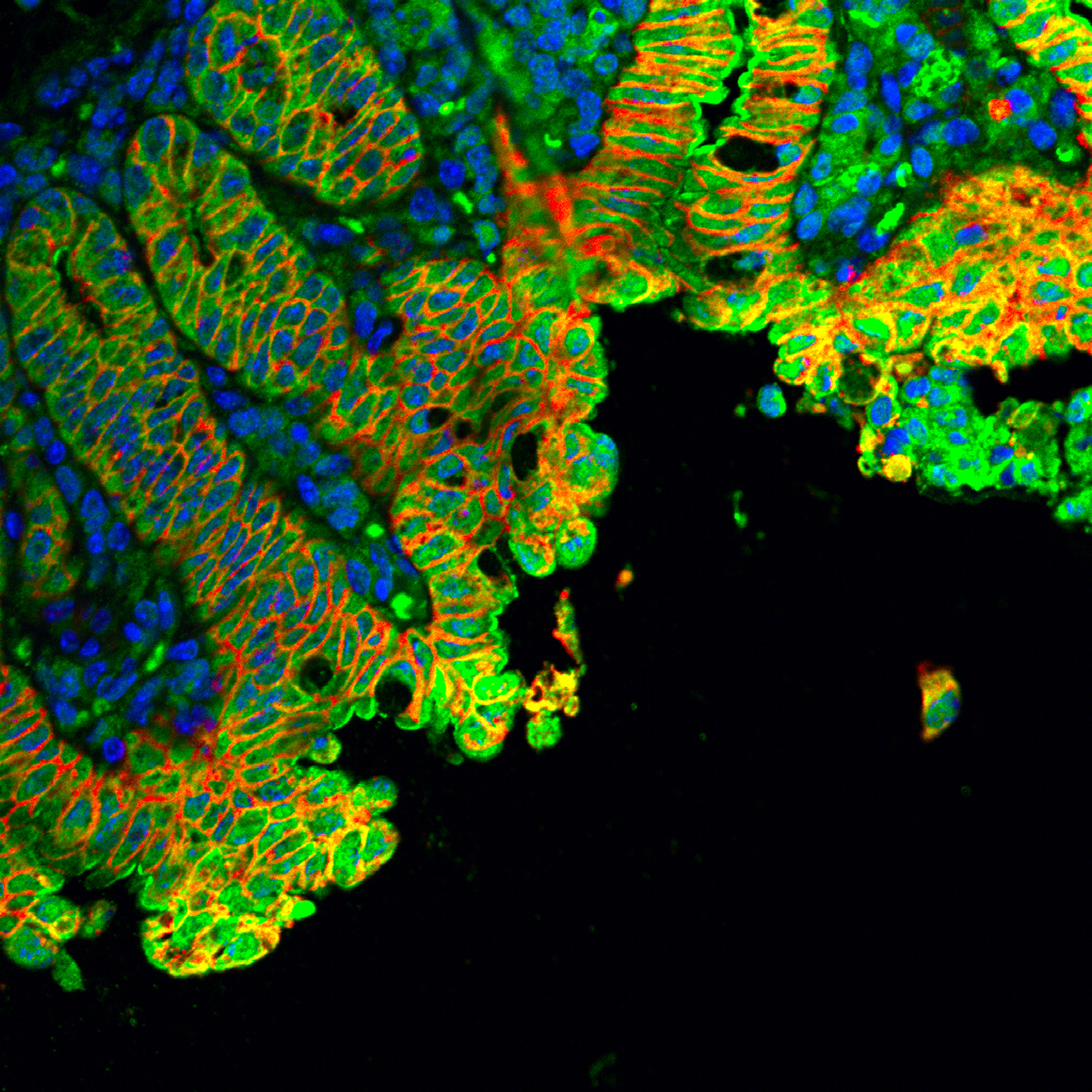- Clone
- Poly4053 (See other available formats)
- Regulatory Status
- RUO
- Isotype
- Goat Polyclonal IgG
- Ave. Rating
- Submit a Review
- Product Citations
- publications

-

Human paraffin-embedded tonsil tissue slices were prepared with a standard protocol of deparaffinization and rehydration. Antigen retrieval was done with Tris-Buffered Saline 1X (1.0M, pH 7.4) at 95°C for 40 minutes. Tissue was washed with PBS/ 0.05% Tween 20 twice for five minutes and blocked with 5% FBS and 0.2% gelatin for 30 minutes. Then, the tissue was stained with 10 µg/ml of purified anti-human CD309/VEGFR2 (clone A16085I) and Alexa Fluor® 594 anti-human PNAD (clone MECA-79) (green) at 4°C overnight, followed by 2.5 µg/ml of Alexa Fluor® 647 anti-mouse IgG (clone Poly4053) (red) for two hours at room temperature. The image was captured with a 10X objective.
| Cat # | Size | Price | Quantity Check Availability | Save | ||
|---|---|---|---|---|---|---|
| 405322 | 100 µg | 183 CHF | ||||
This polyclonal goat anti-mouse IgG antibody reacts with the heavy chains of mouse IgG and with the light (kappa and lambda) chains common to most mouse immunoglobulins. No cross-reactivity has been detected against non-immunoglobulin serum proteins. This antibody has been solid-phase absorbed to ensure minimal cross-reaction with rat, human, bovine, horse, and rabbit immunoglobulins, but it may have minimal cross-reactivity with other subclasses of mouse immunoglobulins.
Product DetailsProduct Details
- Reactivity
- Mouse
- Antibody Type
- Polyclonal
- Host Species
- Goat
- Formulation
- Phosphate-buffered solution, pH 7.2, containing 0.09% sodium azide and BSA (origin USA)
- Preparation
- The antibody was purified by affinity chromatography and conjugated with Alexa Fluor® 647 under optimal conditions.
- Concentration
- 0.5 mg/mL
- Storage & Handling
- The antibody solution should be stored undiluted between 2°C and 8°C, and protected from prolonged exposure to light. Do not freeze.
- Application
-
FC - Quality tested
IHC-P - Verified - Recommended Usage
-
Each lot of this antibody is quality control tested by immunofluorescent staining with flow cytometric analysis. For flow cytometric staining, the suggested use of this reagent is ≤ 0.5 µg per million cells in 100 µL volume. For immunohistochemistry on formalin-fixed paraffin-embedded tissue sections, the suggested use of this reagent is 2.5 - 5.0 µg/mL. It is recommended that the reagent be titrated for optimal performance for each application.
* Alexa Fluor® 647 has a maximum emission of 668 nm when it is excited at 633 nm / 635 nm.
Alexa Fluor® and Pacific Blue™ are trademarks of Life Technologies Corporation.
View full statement regarding label licenses - Excitation Laser
-
Red Laser (633 nm)
- Application Notes
-
This polyclonal goat anti-mouse IgG antibody is useful for capture or detection of mouse IgG in ELISA.
-
Application References
(PubMed link indicates BioLegend citation) -
- Scotta C, et al. 2008. J Immunol. 181:1025-33. PubMed
- Gao X, et al. 2014. Cell Mol Neurobiol. 34:257-68 (ICC)
- Winters T, et al. 2014. EMBO J. 33:1256-70.
- Product Citations
- RRID
-
AB_2563045 (BioLegend Cat. No. 405322)
Antigen Details
- Distribution
-
B cells
- Gene ID
- 16059 View all products for this Gene ID
- UniProt
- View information about IgG on UniProt.org
Customers Also Purchased
Compare Data Across All Formats
This data display is provided for general comparisons between formats.
Your actual data may vary due to variations in samples, target cells, instruments and their settings, staining conditions, and other factors.
If you need assistance with selecting the best format contact our expert technical support team.
 Login / Register
Login / Register 















Follow Us